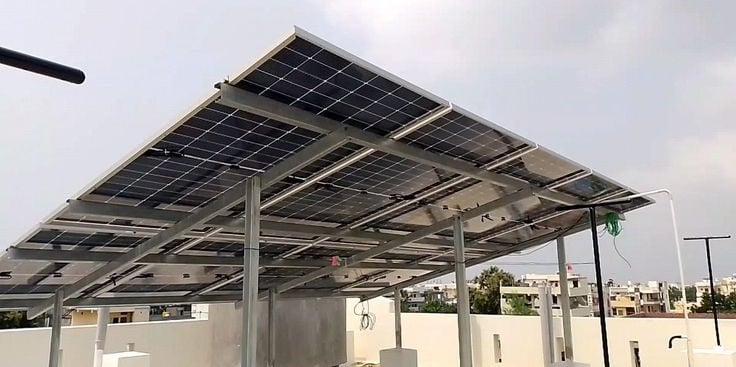How Solar Panels Work: A Simple Guide for Beginners
GENERAL SOLAR AWARENESS


☀️ Introduction: Sunlight to Savings
More citizens in Tamil Nadu and across India have started turning to solar energy due to rise in electricity costs or change in weather patterns. But how does one solar panel seems to power a TV, fridge and water pump all at once?
In this easy-to-read article, I will explain the technology of solar panels, their components, workings, and why it has recently become essential for houses and businesses.
🔬 1. What Are Solar Panels?
Most people know solar panels as PV (Photovoltaic Panels). These panels convert sunlight into electricity using the photovoltaic effect solar energy.
A panel consists of solar cells which is generally made of silicon, a semi-conductive. When solar energy strikes any surface, it causes a reaction. For panels, when the sunlight strikes it, the cells create electricity which is in form of current.
⚡ 2. How Solar Panels Generate Electricity
Let us break the processes it takes to function into 5 steps:
🟨 Step 1: Sunlight Contact Solar Panel
The solar panels capture the light rays from the sun due to their photons (light). The energy coming forward from these photons triggers a negative and positive change.
🟨 Step 2: The Movement of Electrons Begins
Photons within the solar cells make electrons in silicon layers more active. This activity generates DC electricity.
🟨 Step 3: The Inverter Changes DC Into AC
For house and electrical device usage, the current used is alternating (AC), not direct (DC). A solar inverter changes the direct current from the panels into usable alternating current.
🟨 Step 4: Electric Power for the Home is Distributed
AC current circulates within the electrical system pf the home to energize bulbs, lighting fixtures, ventilators, television sets, refrigeration units, and other electrical devices.
🟨 Step 5: Unused Electricity is Sent to the Power Grid (Net Metering)
When the system produces more electricity than needed, the net meter sends the extra power to the grid. You then receive credits on your electricity bill.
🧰 3. Major Parts of a Solar Panel System
Parts Description
Solar Panels: Collect sunlight and produce electricity in direct current.
Power Inverter: Changes direct electricity into alternating current which can be used at home.
Mounting Structure: Fastens panels to the roof or the ground.
Net Meter: Measures net electricity consumed and excess electricity sent to the grid.
Battery (optional): Saves extra power for night time or in the event of power cuts.
Cables & Junctions: Safely and efficiently connects components.
🏡 4. Categories Of Solar Panel Systems
There are three primary classifications of solar systems:
1. Grid-Tied System
Commonly used in urban areas.
Linked to the electricity grid.
Allows net metering (payment or credit for surplus power).
Batteries are not required.
2. Off-Grid System
Best suited for rural areas.
Works completely independent of the grid.
Requires battery storage.
Best for farms, hilly regions, and tribal areas.
3. Hybrid System
Combination of grid + battery.
Additional power during outages.
Offered at a higher cost.
🖼️ 5. Visual Information
Check out this drawing for easy understanding of the process:
📍 6. Reason for Tamil Nadu being Ideal for Solar Energy
Tamil Nadu receives the highest solar energy radiation which is 5.5–6.0 kWh/m²/day.
The area's suitability for solar PV systems is attributed to the 300+ sunny days in a year.
Advantages for the people of Tamil Nadu:
Reduction of grid dependency during peak hours
Government subsidies for residential customers up to ₹78,000
Net metering by TANGEDCO
Affordable EMI and loan options leading to instant ownership
💰 7. Financial Benefit of Solar Panels
Benefit Description
Electricity Bill Savings Saving up to 85% of the costs annually
Government Subsidy Up to ₹78,000 for scheme beneficiaries
Low Maintenance Very little maintenance; lifespan of panels is up to 30 years
Increased Property Value Solar homes have greater appeal to prospective buyers
Eco Friendly Investment Reduction in CO₂ emissions and carbon footprint
🧽 8. Maintenance: The Simple & Easy
The upkeep for solar panels is very simple. Keep the following in mind:
Wash the panels every couple of months to prevent dust buildup.
Do an annual checkup for the wires and inverter.
Ensure no tree branches or other obstructions block the sunlight.
📞 10. Want To Go Solar?
Going green isn't a fad – it's an intelligent and future-ready move for everyone. With us supporting your solar journey every step of the way, whether you’re a resident in Coimbatore, an agriculturist in Madurai, or a business owner in Chennai, TN Solar Solution empowers every one of you to go solar confidently.
🎯 Reach out to us for a site visit or a completely free consultation.
✅ We would determine the correct system size, estimated savings, subsidies, and other relevant details.
📝 In Conclusion
You’re a step closer toward energy independence after understanding how solar panels operate. At TN Solar Solution, we strive to simplify the complex journey of solar development from planning to installation and servicing. Our engineers and energy specialists work as a team on every project to optimize performance and ensure sustainable and enduring results.
📩 For inquiries, write to us at,
📱 +91-8438532816
👉 Get the latest on our projects and solar tips on Instagram, Facebook, and YouTube!
